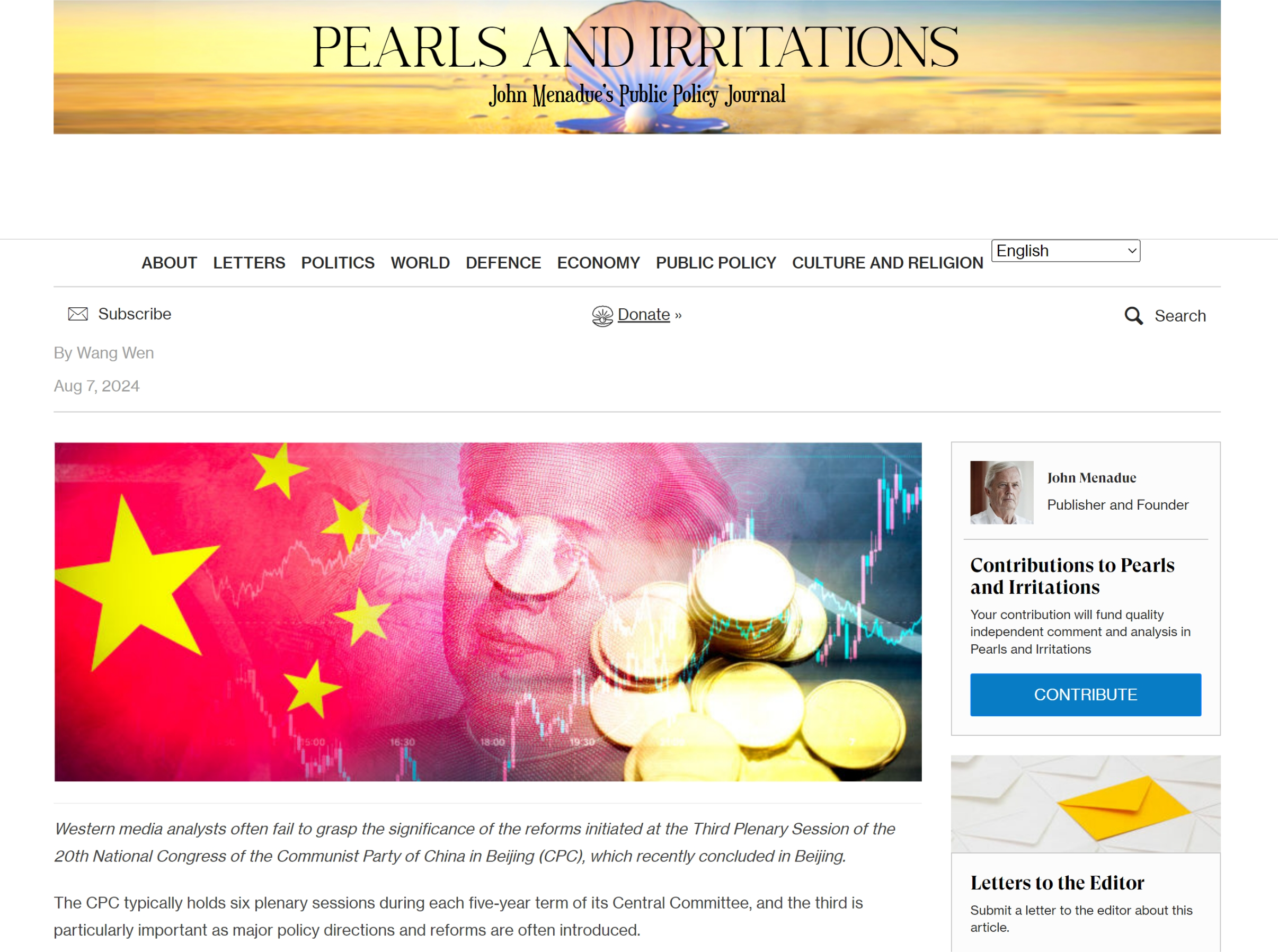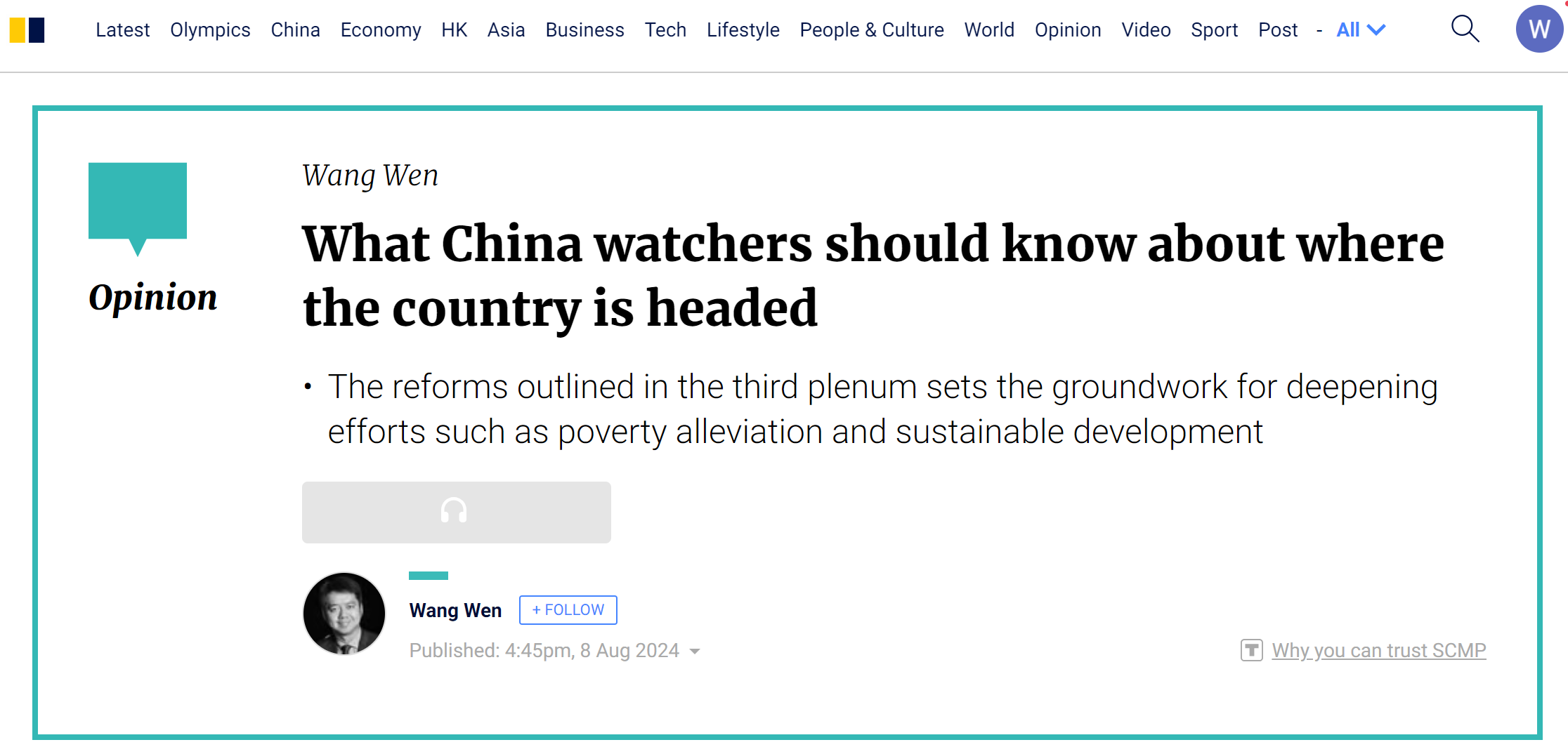发布时间:2024-08-09 作者: 王文
8月7日,澳大利亚知名网站《珍珠与刺激》头条半通栏位置刊发人大重阳执行院长王文《中国六大鲜为人知的斗争和胜利》一文就该报告核心内容的评论文章及其英、日、阿等7种语言版本。8日,香港《南华早报》再次刊发这篇文章,引起国际舆论的广泛关注。
编者按:近日,近20国外交使节、媒体和学者关注报道由中国人民大学重阳金融研究院(人大重阳)领衔的四国合作智库研究报告《攻坚:新时代中国全面深化改革和高水平对外开放进程及2029、2035畅想》。8月7日,澳大利亚知名网站《珍珠与刺激》头条半通栏位置刊发人大重阳执行院长王文《中国六大鲜为人知的斗争和胜利》一文就该报告核心内容的评论文章及其英、日、阿等7种语言版本。8日,香港《南华早报》再次刊发这篇文章,引起国际舆论的广泛关注。现将中、英文版刊发如下:

▲8月7日,澳大利亚知名网站《珍珠与刺激》头条半通栏位置刊发本文
西方媒体分析人士大多未能理解最近在北京闭幕的中国共产党第二十届全国代表大会第三次全体会议所启动的改革的重要意义。中国共产党每届中央委员会都要召开七次全体会议,而第三次全体会议尤为重要,因为它经常推出重大政策方向和改革。
1978年,中国共产党十一届三中全会标志着中国改革开放的开始,邓小平推行的改革开放政策使中国从世界上最贫穷的国家之一转变为第二大经济体。
2013年,十八届三中全会进一步深化改革,确保了中国经济持续增长,为中国成为世界最大经济体奠定了基础。
2024年7月18日,二十届三中全体会议闭幕,提出“进一步全面深化改革”。这是西方分析人士常常低估中国务实发展方针的延续。
持续改革会面临巨大挑战。在西方民主国家,政治候选人竞选时承诺改革,但一两届任期过后,可能并没有什么实际改变。
即使实施了改革,也不能保证继任者不会推翻前任的改革措施。然而,中国把改革当成一场接力赛,每一代领导人都会把接力棒传给下一代。
2012年习近平执政时,中国已是世界第二大经济体,但依然面临重大挑战。过去12年,中国努力解决六大问题——贫困、孤立、污染、腐败、霸权和危机——这些问题经常在中国政治话语中讨论,但西方媒体却很少关注。
1反贫困
2020年底,中国宣布消除极端贫困,比联合国2030年可持续发展目标提前十年实现这一里程碑。2012年至2020年,近9900万人摆脱了极端贫困,这被认为是世界历史上最有效的减贫行动之一。
2反孤立
为应对美国的高科技封锁和贸易限制,中国致力于实现技术独立。
2012年至2023年,中国科研经费占国民收入比重由1.92%提高到2.64%,科研投入全球领先;高新技术企业数量由4.5万家增加到46.5万家,芯片自给率由15%提高到40%以上。
3反污染
中国正在领导世界上最大的减排行动。
2012年至2023年,中国单位国内生产总值能耗下降26.8%,单位国内生产总值二氧化碳排放量下降35%以上。
预计2024年,中国新能源汽车产销量将突破1000万辆,占全球总量的60%左右;中国光伏产业也处于全球领先地位,产量和产能占全球80%以上。
4反腐败
打击腐败是实现可持续发展的关键。2012年至2022年,中国反腐行动查处了457.3万名官员和腐败分子,追捕了11946名逃犯。
5反霸权
中国一贯反对霸权行为,承诺不首先使用核武器,坚持走和平发展道路,这是中国宪法赋予的。中国提出“一带一路”倡议,致力于同世界各国平等合作,推动伊朗与沙特和解、巴勒斯坦内部各派和解。
6反危机
过去12年,中国出台和修改了20多部涉及国家安全、应对房地产泡沫、打击跨国诈骗和网络犯罪的法律。
当然,六大斗争取得的进展并不能掩盖仍然存在的问题,而这些问题正是国家发展下一阶段的目标。
正如邓小平时代的成功改革也不免为未来领导人留下了需要解决的问题一样,过去 12 年的中国改革为进一步全面深化改革奠定了基础。2024 年,二十届三中全会通过了一份长达 22,000 字的关键文件,其中 144 次提到“改革”,并概述了未来五年将实施的 300 多项改革。
这体现了中国45年来坚持改革开放的坚定决心。
我的所在机构重阳金融研究院发布了《决战:中国新时代全面深化改革和高水平开放及2029年和2035年愿景》报告。该报告对未来五年及以后中国的发展轨迹进行了深入分析,提供了值得全球关注的数据。
我想概述中国2029年的目标,并让国际媒体更清楚地了解中国的未来。
到2029年,世界500强企业中将有40%以上是中国企业,中国的GDP预计将超过美国的85%,到2035年可能成为世界最大经济体。
中国人口平均寿命将超过80岁,基本医疗和养老覆盖率将超过95%。2029年与中国互免签证、单边免签证和落地签的国家将超过100个。到2035年,这一数字将超过120个。
全国三分之一以上的人口(超过4亿人)将出国旅游。环境方面,中国将提前实现碳排放达峰,引领全球减排努力。从安全角度看,中国将成为世界上综合安全水平最高的国家之一。
随着中国航天员登陆月球的计划,中国每年将生产200架国产大飞机,并新增5个海外保障基地。
更重要的是,到2029年,中国共产党的国家治理能力和治理体系将再迈出一大步,一个基本实现社会主义现代化的中国将崛起。

▲8月8日香港《南华早报》刊发本文
以下为文章的英文版
The CPC typically holds six plenary sessions during each five-year term of its Central Committee, and the third is particularly important as major policy directions and reforms are often introduced.
In 1978, the Third Plenary Session of the 11th Central Committee of the Communist Party of China marked the beginning of China’s reform and opening-up, a policy introduced by Deng Xiaoping that transformed China from one of the world’s poorest countries into the second-largest economy.
In 2013 the Third Plenary Session of the 18th Central Committee further deepened these reforms, ensuring China’s continued economic growth and setting the stage for it to one day become the world’s largest economy.
On July 18, 2024, the Third Plenary Session of the 20th Central Committee concluded with a proposal for “further comprehensive deepening of reform,” a continuation of China’s pragmatic approach to development that Western analysts often underestimate.
Long-term reform is a challenge. In Western democracies, political candidates campaign on promises of change, but after one or two terms, little may actually change.
Even if reforms are implemented, there is no guarantee that a successor won’t reverse them. China, however, approaches reform as a relay race, with each generation of leaders passing the baton to the next.
When Xi Jinping took over in 2012, China was already the world’s second-largest economy, but significant challenges remained.
Over the past 12 years China has tackled six major struggles ‒ poverty, isolation, pollution, corruption, hegemony and crises ‒ issues often discussed in Chinese political discourse but seldom noticed by Western media.
1. Anti-Poverty
By the end of 2020 China announced the eradication of extreme poverty, achieving this milestone a decade ahead of the United Nations’ 2030 Sustainable Development Goals. From 2012 to 2020, nearly 99 million people were lifted out of extreme poverty in what is considered one of the most efficient poverty alleviation campaigns in global history.
2. Anti-Isolation
In response to high-tech blockades and trade restrictions imposed by the United States, China has focused on achieving technological independence.
Between 2012 and 2023, China’s scientific research funding as a percentage of national income increased from 1.92 percent to 2.64 percent, making it the global leader in research investment. The number of high-tech enterprises rose from 45,000 to 465,000 and the chip self-sufficiency rate increased from 15 percent to over 40 percent.
3. Anti-Pollution
China is leading the world’s largest emissions reduction initiative.
From 2012 to 2023, China’s energy consumption per unit of GDP dropped by 26.8 percent and carbon dioxide emissions per unit of GDP fell by more than 35 percent.
The country’s new energy vehicle production and sales are set to surpass 10 million units in 2024, accounting for about 60 percent of the global total. China’s photovoltaic industry is also a global leader, with output and production capacity accounting for more than 80 percent of the world’s total.
4. Anti-Corruption
Tackling corruption is crucial for sustainable development. Between 2012 and 2022, China’s anti-corruption campaign saw 4.573 million officials and corrupt elements investigated and punished, with more than 11,946 fugitives brought to justice.
5. Anti-Hegemony
China has consistently opposed hegemonic behaviour, pledging never to use nuclear weapons first and adhering to peaceful development as enshrined in its constitution.
China has proposed the Belt and Road initiative, committed to equal cooperation with countries around the world and promoted Iran-Saudi reconciliation and reconciliation between factions within Palestine.
6. Anti-Crisis
Over the past 12 years, China has introduced and revised more than 20 laws related to national security, addressed real estate bubbles and cracked down on transnational fraud and cybercrime.
Of course progress in these six struggles cannot conceal the fact that there are still problems. These are precisely the targets for the next phase of national development.
Just as the reforms of Deng Xiaoping’s era left issues for future leaders to address, the reforms of the past 12 years have set the groundwork for further comprehensive deepening. In 2024 the Third Plenary Session of the 20th Central Committee passed a 22,000-word key document which mentions “reform” 144 times and outlines more than 300 reforms to be implemented over the next five years.
This reflects China’s unwavering commitment to reform and opening-up over the past 45 years.
My institution, the Chongyang Institute for Financial Studies, launched the report Decisive Battle: China’s Comprehensive Deepening of Reform and High-level Opening-up in the New Era and Visions for 2029 and 2035. This report provides insights into China’s trajectory over the next five years and beyond, offering data worthy of global attention.
I’d like to outline China’s goals for 2029 and give international media a clearer perspective on China’s future.
By 2029, more than 40 percent of the world’s top 500 companies will be Chinese and China’s GDP is expected to surpass 85 percent of the United States, potentially becoming the world’s largest economy by 2035.
Average life expectancy in China will have surpassed 80 years old while basic medical and pension coverage will exceed 95 percent.
In 2029 there will be more than 100 countries who share mutual visa exemption, unilateral visa exemption and visa on arrival with China. There will be more than 120 by 2035.
More than one-third of the country’s population ‒ over 400 million people – will have traveled abroad.
Environmentally, China will achieve its carbon peak ahead of schedule, leading global efforts in emission reductions.
In terms of security, China will become one of the countries with the highest comprehensive security in the world.
With plans for Chinese astronauts to land on the moon. China will produce 200 domestic large aircraft a year and five new overseas support bases will be added.
More importantly by 2029, the national governance capacity and governance system of the Communist Party of China will take another big step forward. A China will emerge that has basically achieved socialist modernisation.
(欢迎关注人大重阳新浪微博:@人大重阳 ;微信公众号:rdcy2013)